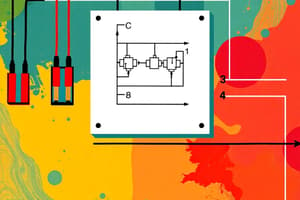Podcast
Questions and Answers
What is the typical voltage range used in electronic circuits?
What is the typical voltage range used in electronic circuits?
- 8V, 16V, 32V, 220V
- 3V, 6V, 9V, 120V
- 5V, 12V, 24V, 110V (correct)
- 2V, 10V, 20V, 100V
In what component would you typically find the usage of 5 Volts in an electronic circuit?
In what component would you typically find the usage of 5 Volts in an electronic circuit?
- Resistors
- Microprocessor (correct)
- Relay circuit
- Lamp
What is the purpose of an electrical wiring diagram?
What is the purpose of an electrical wiring diagram?
- To represent life-like depictions of a circuit
- To provide a simulation of the circuit's working condition
- To physically connect electrical components in a circuit
- To show how electrical components are connected using symbols (correct)
What load could be found in an electronic circuit that creates the flash in a camera?
What load could be found in an electronic circuit that creates the flash in a camera?
Why is it important to take necessary safety precautions before working on any wiring connection?
Why is it important to take necessary safety precautions before working on any wiring connection?
What is the main difference between a wiring diagram and a schematic?
What is the main difference between a wiring diagram and a schematic?
Which voltage level is typically used in an electronics relay circuit?
Which voltage level is typically used in an electronics relay circuit?
Who usually creates electrical and electronic diagrams before they are printed?
Who usually creates electrical and electronic diagrams before they are printed?
What is the role of electronic circuits in the digital world?
What is the role of electronic circuits in the digital world?
In an electrical circuit, what do schematics primarily focus on representing?
In an electrical circuit, what do schematics primarily focus on representing?
Flashcards are hidden until you start studying
Study Notes
Electronic Circuit Diagrams
- A circuit diagram is a drawing that represents an electronic circuit.
- Soldering guns or special machines are used to complete electronic circuit connections.
Electrical Circuit Diagrams
- A wiring diagram is a drawing that represents an electrical circuit.
- Electrical circuit components, such as flexible cables, are used to connect.
- Electrical wiring diagrams are typically performed at 220 Volts or 110 Volts, and require necessary safety precautions to avoid short circuits.
Diagram Creation and Symbols
- Both electrical and electronic diagrams are usually drawn by draftsmen and then printed.
- Diagrams can also be created digitally using specialized software.
- Wiring and circuit diagrams use special symbols to represent components, such as resistors, capacitors, insulators, motors, outlet boxes, lights, and switches.
- These symbols show how components are connected and help simulate the circuit.
Schematics
- A schematic is a diagram of an electrical circuit that graphically represents the essential connections.
- Schematics use symbols to represent components, but are not life-like depictions of a circuit.
Electronic Circuit Voltages
- Electronic circuits typically use low voltage direct current sources, such as 5V, 12V, or 24V.
- 5V is commonly used in microprocessors, 12V in resistors, and 24V in electronic relay circuits.
- 110V is commonly used in electrical wiring diagrams, such as circuit breaker wiring and protection relay wiring.
Examples of Electronic Circuits
- A simple electronic circuit may consist of resistors, capacitors, and a lamp, connected to create a flash in a camera.
- A complex electronic circuit may consist of thousands of resistors, capacitors, and transistors.
- Examples of electronic circuits include smartphones, microprocessors in computers, and integrated circuits.
Studying That Suits You
Use AI to generate personalized quizzes and flashcards to suit your learning preferences.




